
Even St. Nick uses a light load whenever possible. On the trail from Lyon to Le-Puy, France 2009.
Making Light ~ Clothing
Take only as much as you need
It may seem obvious that if you want to minimize your pack weight, you shouldn’t carry any more of anything than you’re likely to need. (Congratulations – if you’ve read this far, maybe you’re hooked on the idea.) But how much is that?
Here are some tips to help you answer that question when it comes to clothing.
Study the climate, weather, terrain (especially elevation) of the route and season of your walk. Consider how you plan to deal with inclement weather.
Generally, I’m more than happy to walk in the rain. On the other hand, Bruce Lefavour, who wrote the excellent book France on Foot, generally doesn’t. (Maybe that’s why we’ve never met on trail.)
He often uses “bad weather” as a way to enjoy a rest day, relaxing in the local bars and cafés, while I tend to keep moving. I find it’s generally cooler, if also muddier. Bruce and I probably have different requirements for rain gear, even if we’re marching down the same Grande Randonnée at the same time of year. (Maybe I passed him one day, because I walked on, while he stayed inside warm and dry – if so, I’m sorry I missed him!)
In any case, to attain the maximum weight-to-utility ratio, you would design your wardrobe so that you can (and will) wear everything, as in All Your Clothes in the worst possible conditions you might encounter.
Greg Van Peski, who founded Gossamer Gear, and Ryan Jordan, of Backpacking Light, have been driving this point home for years regarding wilderness camping, where they snuggle into their sleeping bag or quilt wearing
- everything
they have on the coldest night. The same principal works for those of us who are merely walking to the next warm bed this evening.
There’s some good news here! Almost all of the time, you won’t face the coldest, worst conditions you’re likely to encounter. But that means, instead of wearing all your clothes, you’ll be carrying many of them. Therefore, figuring out what your “minimum maximum” clothing needs are means you’ll be hauling the least possible wardrobe on your back most of the time. And when you’re not carrying it, you’ll be very happy that you brought it along to wear.
Synthetic or wool fabrics are the quickest drying and make the best choices for clothing. When you get to the end of the day’s trail, just give them a quick rinse if necessary, and they should be good to go the next day.
Since I’m likely to be spending the night in someone’s home (a Bread & Breakfast) or dining in a village restaurant, I want to be at least somewhat presentable, so I like to arrive with a clean, dry shirt and pants, but beyond that, I really don’t need much more. In the worst weather I’ve encountered (a cold, wet, windy day), I wore nearly everything I had under my rain suit, and when I arrived, I was so wet and bedraggled, the kind proprietress took one look at me and said, “Would you like me to do some laundry for you?” Soon I was back in warm, dry clothes again. That was the worst case for me, and has only happened once in nearly 200 days of walking the trails of Europe.




